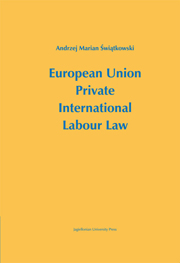Book contents
- Frontmatter
- Contents
- Introductory Comments
- Part I Preliminary Part
- Part II Conflicts of law of individual labour law in the light of the Rome Convention of June 19, 1980 and Regulation of the European Parliament and the Council of the European Communities No. 593/2008 of June 17, 2008 on the law applicable to contractual obligations (“Rome I”)
- Part III Conflict of law issues in individual labour law in light of the Regulation (EC) No. 864/2007 of the European Parliament and the Council of the EU (July 11, 2007), concerning law applicable to Non-Contractual Obligations (“Rome II”)
- Part IV Conflicts of law in collective labour law
- Introduction
- Chapter 1
- Chapter 2 Regulation (EC) No. 864/2007 of the European Parliament and the Council of July 11, 2007 concerning the law applicable to non-contractual obligations (“Rome II”) resulting from collective actions
- Part V Conflicts of law in social security – the coordination of national social security systems of EU Member States according to the regulation of the European Parliament and Council Regulation (EC) No. 883/2004 of April 29, 2004 on the coordination of social security systems
- Part VI International procedural labour law of the European Union
- Selected bibliography
Chapter 2 - Regulation (EC) No. 864/2007 of the European Parliament and the Council of July 11, 2007 concerning the law applicable to non-contractual obligations (“Rome II”) resulting from collective actions
from Part IV - Conflicts of law in collective labour law
Published online by Cambridge University Press: 05 September 2014
- Frontmatter
- Contents
- Introductory Comments
- Part I Preliminary Part
- Part II Conflicts of law of individual labour law in the light of the Rome Convention of June 19, 1980 and Regulation of the European Parliament and the Council of the European Communities No. 593/2008 of June 17, 2008 on the law applicable to contractual obligations (“Rome I”)
- Part III Conflict of law issues in individual labour law in light of the Regulation (EC) No. 864/2007 of the European Parliament and the Council of the EU (July 11, 2007), concerning law applicable to Non-Contractual Obligations (“Rome II”)
- Part IV Conflicts of law in collective labour law
- Introduction
- Chapter 1
- Chapter 2 Regulation (EC) No. 864/2007 of the European Parliament and the Council of July 11, 2007 concerning the law applicable to non-contractual obligations (“Rome II”) resulting from collective actions
- Part V Conflicts of law in social security – the coordination of national social security systems of EU Member States according to the regulation of the European Parliament and Council Regulation (EC) No. 883/2004 of April 29, 2004 on the coordination of social security systems
- Part VI International procedural labour law of the European Union
- Selected bibliography
Summary
The conflict rule included in Article 9 of Regulation No. 864/2007 regulates the collisions of national collective labour laws only in matters relating to the liability of individuals (workers, employers) participating in collective actions, in connection with the initiated or planned industrial action. The provision contains a determinant to indicate the relevant provisions of the collective labour law, which govern the responsibility of the organisation representing the professional interests of the parties to the collective dispute for damage caused by a planned or carried out collective labour dispute. The law applicable to assess the legal implications of the effects of intentional and/or carried out collective action is the collective labour law of the Member State in which the industrial action was initiated or had been announced. It should be noted that Article 9 of this regulation has applied the formula used in Article 4, paragraph 2 of this Regulation, defining the relationship between the general principle of liability for the obligations arising out of non-contractual agreements and the exceptions to the rule under which the applicable law is lex loci damni (Article 4, paragraph 1). In the event of any liability of the participants of a collective dispute, Article 9 of the Regulation No. 864/2007 in fine states as an appropriate collective labour law of the Member State in which the action is to be or has been taken.
- Type
- Chapter
- Information
- European Union Private International Labour Law , pp. 190 - 198Publisher: Jagiellonian University PressPrint publication year: 2012



